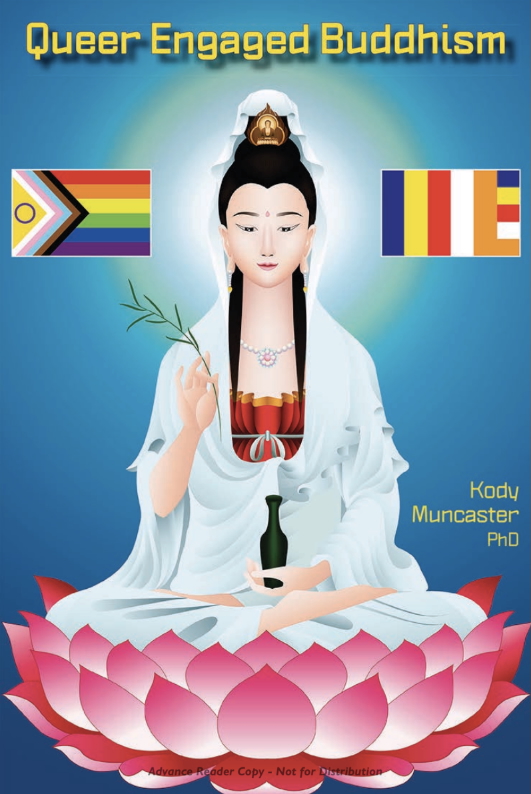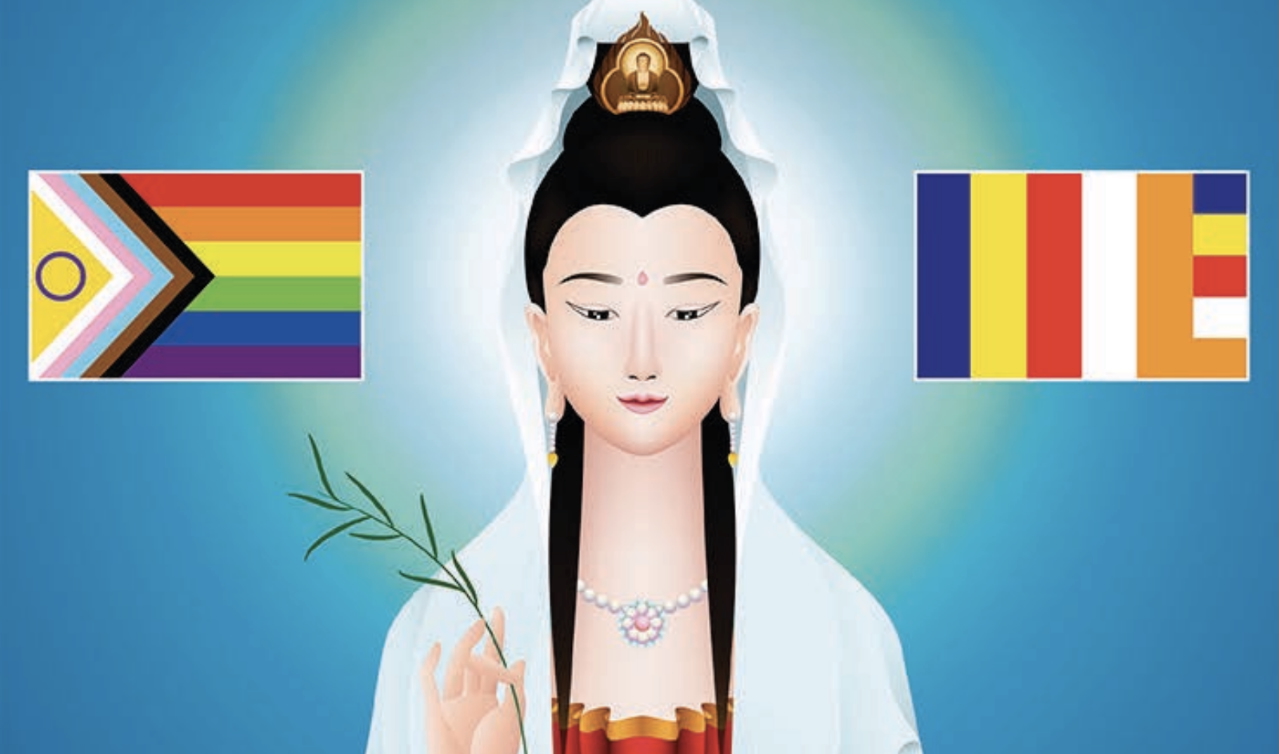The Buddhist emphasis on the concept of non-duality can be understood in relationship with non-binary identity, not to suggest that everyone must be non-binary, but rather, as an affirmation of the unique gifts of non-binary worldviews. Shantideva’s use of non-dualistic philosophy to argue that we need not see a separation between self and other can be used in conjunction with queer theory to extend its implications to trans identity by transcending gender and sexual binaries. Queer theory has explored the trajectory of the social, political, cultural, and linguistic construction of gender and sexual identities, and queer theory’s conceptualization of this construction can be compatible with Buddhist notions of emptiness. Often, emptiness is used against queer people to devalue our identities. I want to be clear that emptiness does not mean that something does not conventionally exist. Here, we are simply noticing how interesting it is that while gender and sexual diversity have always existed, the way we conceptualize these topics as, for example, identities, changes across time periods and cultures.
These identities are important to us and the history of their construction can also unearth the construction of the more privileged identities of cisgender and heterosexual people. Judith Butler (1988) argues that gender is performative, which is often misunderstood to mean that all gender is drag. What is meant by the use of the term “performative” is that gender is reified through its own repetition and constructed through discourse and language in a specific time period.
This is somewhat similar to Michel Foucault’s (1990) discussion of how “the homosexual” was linguistically produced as a category of being, which actually came into language before the term “heterosexual” was eventually coined as its opposite. In unearthing the discursive construction of homosexuality, Foucault, a queer person himself, is not denying the validity of homosexuality just as Butler, a non-binary person, is not attempting to invalidate trans identity. Rather, the two authors are exploring how the concepts as we have come to know them today have been developed in language in a particular time period and have social, political, and medicalized connotations.
Butler argues that drag is not an imitative copy of another gender but rather it “enacts the very structure of simpersonation by which any gender is assumed… gender is a kind of imitation for which there is no original,” explaining that it is through daily repetition across thousands of years that gender as we know it today reconstitutes itself. Similarly, they discuss how homosexuality is seen as a bad copy of heterosexuality, even though the term “homosexual” came first in language, an approximation to which it can never quite reach, explaining:
Heterosexuality here presupposes homosexuality. Furthermore, if the homosexual as copy precedes the heterosexual as origin, then it seems only fair to concede that the copy comes before the origin, and that homosexuality is thus the origin, and heterosexuality the copy. But simple inversions are not really possible. For it is only as a copy that homosexuality can be argued to precede heterosexuality as the origin.
Butler’s work destabilizes the copy/origin dualism that is at the heart of naturalistic arguments around cisgender and heterosexual hegemony. Their work lends itself well to the newly developed field of queer ecologies as we divest from biological determinism, a perspective that always positions queer and trans as, even implicitly, a biological defect. The search for biological origin is rooted in eugenics with the underlying premises of cishetero as default and of eradicating queerness. This can be related to Buddhist notions of codependent arising that explain that all things have interrelated causes and conditions. The concept of heterosexuality as a linguistic and social category arose as the supposed opposite to homosexuality.
There can also be a search for origin in karma. Ocha (2023) surveyed Thai kathoey sex workers, kathoey being a non-cisgender form of identity (though Ocha argues that it is more of a collection of identities), unique to Cambodia, Laos, and Thailand, on their relationship to religion, gender, and sexuality. The majority of respondents felt that they were born as kathoey due to bad karma, internalizing negativity toward gender diverse people.
On the other hand, they also used non-essentialist philosophies in Buddhism for self-empowerment. In the Acintita Sutta, the Buddha stated that the results of karma should not be speculated about, for doing so can cause madness and frustration. No one can tell you what your karma is or what has led to your current situation. In the Samyutta Nikaya, the Buddha taught that not everything is due to karma. Things can occur due to bodily elements, the weather, behaviour, external sources, or karma. My teacher once stated: the only bad karma is things that you wish were not happening, meaning that things become characterized as having to do with bad karma because we have labelled the situation itself as bad or unwanted. If we apply that to queerness, then when we experience internalized queerphobia, we may think that our queerness is due to bad past karma, but when we see queerness as a gift, it becomes due to good past karma. Many of the participants in Ocha’s study saw their clothing as simply a shelter for the body and reached deep, spiritual understandings of gender.
The distinction between conventional and ultimate realities can be helpful in teasing out the relevance of the above theoretical work while avoiding the risk of invalidating contemporary identity categories. These two truths exist in both Theravada and Mahayana Buddhism, though they were most fully explored by Nagarjuna, who founded the Madhyamaka school. Conventional reality, also known as relative reality, is that which we see in front of us, our taken-for-granted understandings of the world. Ultimate reality, also known as absolute reality, is non-dualistic, empty, and boundless.
If we look deeply, we can realize that there is no true distinction, that we need both, and that the two are interdependent, but this linguistic distinction can aid us in ensuring that Buddhist social justice aims are not minimized through false notions of ultimate truth on behalf of more privileged practitioners.

Zenju Earthlyn Manuel (2015), the first Black person to receive Dharma transmission in Suzuki Roshi’s Soto Zen lineage, is a lesbian Zen priest who explores this more deeply in her book The Way of Tenderness: Awakening Through Race, Sexuality, and Gender. Absolute truth can be misunderstood and used to maintain whiteness and heterosexual hegemony through the misrepresentation of non-self and non-duality, but the absolute can only be realized through the relative.
Manuel explains that the Satipatthana Sutta prescribes the practice of mindfulness of the body and that we cannot be disembodied selves, ignoring our identities for the sake of some higher spirituality. Our relative experiences of the body are marked by social experiences of race, gender, and sexuality within a historical and cultural context. Manuel argues that we must not create a hierarchy between spiritual awakening and social identity and must instead understand deeply the inseparability of the relative and absolute, explore multiplicity in oneness, and understand that sameness does not erase difference.
A queer Buddhist Studies can consider sexuality and gender from the non-dual position, disentangling the binaries of male/ female and heterosexual/homosexual that are so often used in attempts to write bisexual and non-binary people out of existence, through understanding the emptiness of these categories. For something to be empty does not mean that it does not hold real meaning for people; otherwise this could be misapplied to harm binary trans people just as non-self has been continually used in attempts to try to convince queer Buddhists to divest from their queer identities and, by extension, to depoliticize our activism. On the conventional level these are real categories that have meaning, and these categories are sometimes helpful for queer political aims.
On the ultimate level we can allow for a deeper understanding of their histories and fluidity, and this ultimate understanding enables an exploration of differences in queer epistemologies across cultures. Here, we want to avoid the dominance of Western ways of knowing, though a relative term may be applied with acknowledgment of its limitations and contextualization for the purposes of writing an English language book.
Like all concepts in Buddhism, non-self is an experiential tool for mind training rather than a denial of the relative existence of beings who are required to self-label for the sake of cultural intelligibility, though it may evidently be misappropriated. José Muñoz’s work on queer ephemera in the archives builds on Kate Kent’s call that we maintain queerness as an expectation in reading history given the dominance of heteronormative assumptions that allow even images of men kissing to be labeled by historians as “best friends.”
It is because of the ephemerality that has been forced on queer existence in the archives that we are put into the position of defending the queer self. We can again return to Butler’s discussion on which came linguistically first, but it may be more productive to instead reassert the need for conventional and ultimate distinctions in addition to compassion on the part of the cis-gender, heterosexual people who feel compelled to remind queers of the non-self. It may be more productive for cisgender, heterosexual practitioners to work on empathizing with the experience of the erasure of an important part of one’s life.
Excerpted with permission from Queer Engaged Buddhism, by Kody Muncaster (Sumeru Books, 2025).


